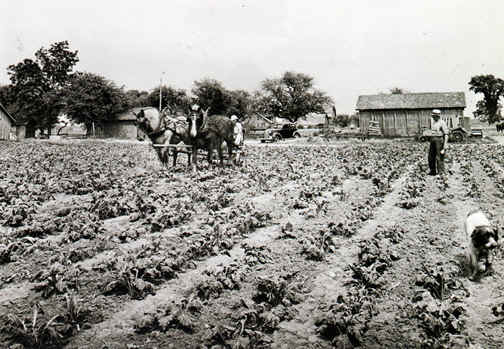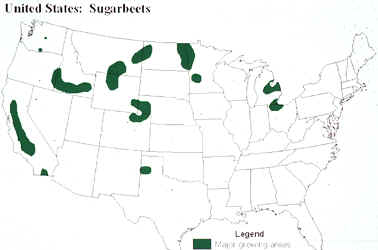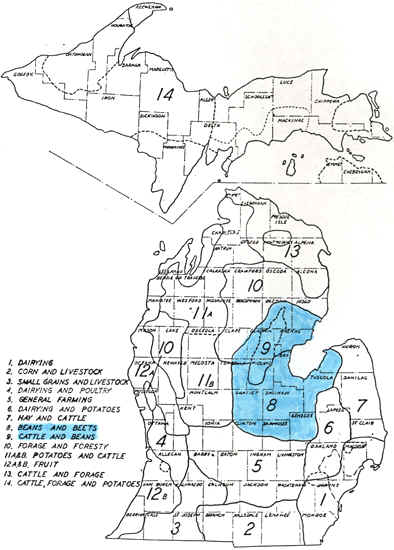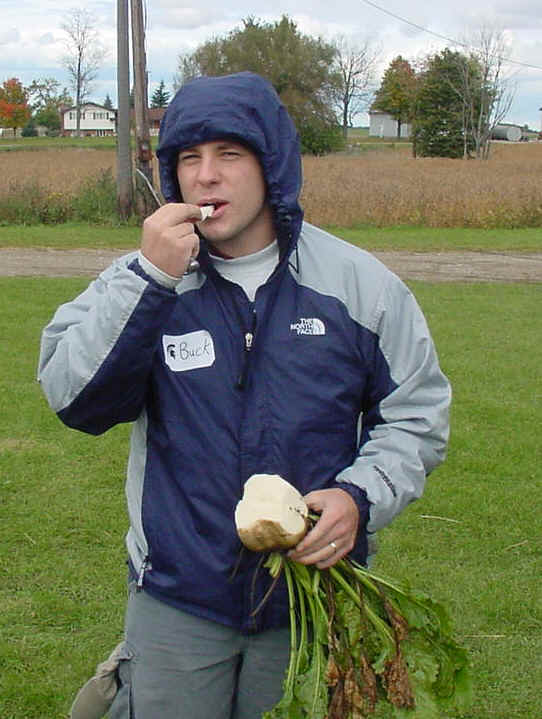"A mature sugar beet measures up to a foot long, weighs three to five pounds and can produce about five ounces of sugar. Roughly 18 percent of the beet is pure sugar." said Michigan Sugar manager of communications Mitch Reno. These beets, which grow from tiny seed to burly beet in just one growing season, can have tap roots as deep as ten feet in a dry year. Mahar added, although typically they stay in the four-to five-foot range. "Michigan is a wonderful, reliable place to grow sugar beets," Mahar said, thanks to its overall weather and particularly autumn’s sunny days and cold nights. "When it’s cooling down at night the sugar drops from the foliage into the beet plant. The sugar beet pretty much can handle all problems of nature - drought or damp. In the early part of the century black-root disease and blight were common out west," he said. But Michigan is a fairly disease-resistant state. "The bitter cold of January and February just sanitizes our soil." A more difficult time was in the late 1970s and early 1980s when soft-drink bottlers switched from sugar to high-fructose corn sweetener. "That cut down the sugar consumption in the United States," he said. "[When] all of a sudden somebody comes out with this other kind of sweetener and takes away Coca-Cola, you’ve lost a pretty good-sized customer."
The sugarbeet plant is a root crop which grows underground. When fully grown, a sugarbeet weighs two to five pounds and produces about three teaspoons of sugar. Michigan sugar beet farmers harvested 130,000 acres of crop in 1996, ranking Michigan 5th in the nation in sugar beet production. Michigan's Saginaw Valley and Thumb area, along with the southeast corner of the state, produces more than 90% of the sugar beets grown east of the Mississippi River. The high quality sugar is a result of growers and companies working closely together to ensure that each crop of sugar beets uses the "best management practices", resulting in a healthy product at harvest.
Mention the word sugar, and many people think of what one adds to
coffee (white sugar, sucrose). Other types of sugar include confectioners sugar - a
combination of table sugar and corn starch - and maple sugar, a sucrose that is contracted
from the sap of a maple tree.
Not all sugar beets are processed into sugar, however. Beet pulp is
used as cattle feed and dog food. Molasses, a byproduct of processing, is used to
make citric acid, vinegar, yeast and antibiotics.
Michigan is a major grower/producer of sugar beets.
Beets have been grown here for many decades, as the 1939 image below indicates.

The other major areas in the US where sugar beets are grown (map below) are all in the dry, western states, where irrigation is essential.

Source: http://spectrumcommodities.com/education/commodity/sb.html
Beets are grown on the two major glacial lake plains of the state: the Saginaw lowlands
and the Lake Maumee plains near Toledo.

Source: Hill, E.B., Riddell, F.T., and F.F. Elliot. 1930. Types of farming in Michigan. Michigan Agricultural Experiment Station Special Bulletin 206.
The latter area is growing less and less beets each year. Several large sugar
production facilities are located within the Saginaw lowlands, near to the beet farms
(beets are heavy and do not transport well; they are also perishable).
Producers plant about five sugarbeet seeds per foot. Only half of those will develop into
plants, but the plants still grow too thick to produce a quality crop. Producers must chop
out extra beets so there is only one beet every 6 to 10 inches. This is called
"thinning" the beets. Some producers use mechanical thinners, an attachment for
a tractor that thins 6 to 8 rows of beets at one time. Other producers hire seasonal
workers to thin the beets and chop the weeds during the growing season.
Acres planted to sugarbeets in Michigan continued to rise in 1993, with
189,000 acres planted. This was the eleventh straight year acreage has increased and is
the largest planted acreage since records began in 1924. Harvested acreage was also at
it’s peak with 187,000 acres of beets pulled in 1993. Total production was up 3% from
1992, to 3.18 million tons, even though average yields dropped 0.7 tons, to 17.0 tons per
acre.
Source: Photograph by Randy Schaetzl, Professor of Geography - Michigan
State University
Sugar beets are white in color, and quite sweet.

Source: Photograph by Randy Schaetzl, Professor of Geography - Michigan
State University
Typical yields are about 15-20 tons per acre.
Source: Photograph by Randy Schaetzl, Professor of Geography - Michigan State University
Sugar made from sugar beets is identical to that made from sugar cane. Brown sugar and molasses (the kind for human consumption), however, come only from the processing of sugar cane.
Some of the text on this page has been taken from an isue of Michigan History magazine: SWEET SMELL OF SUCCESS by Laura Bennett-Kimble
This material has been compiled for educational use only, and may not be reproduced without permission. One copy may be printed for personal use. Please contact Randall Schaetzl (soils@msu.edu) for more information or permissions.